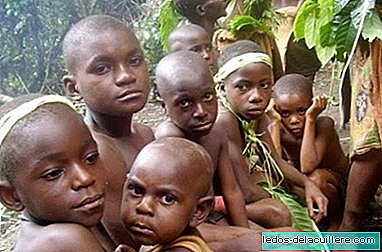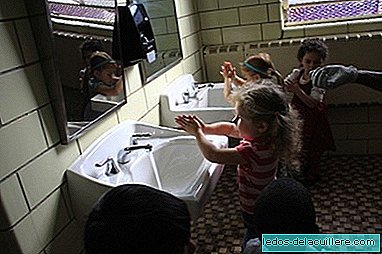
We publish on Wednesday the first part of this interview with the anthropologist María José Garrido and today we continue talking with her.
He has explained to us how the most loving upbringing is done in non-violent societies and, at the same time, detached upbringing is the basis of societies that practice aggression and war. We want to deepen the way in which the raising of children is decisive in the form of society in which we live.
Is education and parenting designed to get a model citizen?
That's right, each culture shapes its individuals through upbringing, favoring certain values to the detriment of others.
In the industrialized countries of the West, independence, individual success, private property or competitiveness is encouraged; while in traditional cultures the concept of community prevails over the individual, so that social cohesion is favored. Therefore, the values that are encouraged are reciprocity, mutual help, cooperation and social solidarity. There is no doubt that all the rules on parenting: breastfeeding, feeding, how they should sleep, attitude towards crying children, degree of physical contact with babies, etc. They are not a product of chance, but have a social function.
What was the role of parents in traditional societies?
The one to transmit the values of the group. The first socialization of children occurs in the family, which constitutes the first context of reference about the world. Our concept of ourselves, of human relations and of the world, are gestated in childhood. Later it can be attenuated, but the tendency of our character, the way of managing emotions and our worldview, will be the ones we learned in the first place. Hence the importance of parenting, since in childhood there is the germ of the society of the future.
There is much talk about the patriarchal culture paradigm, but did the matriarchal cultures exist or should this concept be qualified?
There is no consensus among anthropologists about whether there are or have existed matriarchal groups, an issue that can be explained because they do not find characteristics of gender inequality as marked as in patriarchal ones. Matriarchal groups seem to have not had a marked inequality of power as in patriarchy. But, more than a political primacy of women, it would be collaboration in common ends by men and women. Although its power extends to the economic and social spheres, the tendency is to make decisions by consensus. In these contexts, women are the basis of the entire social structure. For example, it was documented among the Iroquois (Brown, 1975), where women controlled the local economy by owning the land and controlling alliances. In Malaysia, in Negeri Sembilan, women have traditionally been the owners of rice fields. In Indonesia, the minangkabau of West Sumatra are matrilineal, as are the Trobrian islanders of the South Pacific. The ache of Paraguay are matrilocal, so that, after marriage, the couple lives with the woman's family. For their part, the Nayar live on the Malabar coast in India in domestic groups headed by women. Between them, the husband and wife do not share the same residence. It is a matrilineal society in which each of the members of the couple lives with their matrilineal group. In some societies in Indonesia, West Africa and the Caribbean, there are also matrifocal groups, whose organization is centered on the mother, since men are far away for long periods, even if it is not a matriarchy in the sense of the patriarchy we know, since political power is held by men, although they are the ones they designate, as occurs among the Mosuo in China. Also in China, the "na" have a social structure of families headed by women, without husbands or parents, sharing the same residence.
Do we know anything about these cultures about their upbringing? I refer to matriarchal, matrilocal or matrilineal and matrifocal.
The minangkabau, for example, are characterized by an emphasis on including the maternal in everyday life. They make the maternal the axis of life and social order. Among the nayar, children are cared for by the group, not knowing in many cases their genitor. It seems clear that in those societies in which women control marriages and other aspects of social life, both women and men have different partners, sexuality is more flexible and the responsibilities of raising children are blurred.
Was the patriarchate born with the possession of land and agriculture?
Although all human societies have some kind of division of labor based on gender and age, everything seems to indicate that, as of the Neolithic period, 10,000-12,000 years ago, with the emergence and diffusion of agriculture, as well as with the domestication of animal species, there was the beginning of the process of social inequalities. On the one hand, by increasing food production and its need to accumulate and manage them, the population increased considerably, became sedentary and required certain individuals to control this surplus of production. It went from reciprocity to redistribution and, subsequently, to market exchange, characteristic of the states. It also required that social relations be regulated, going from the size of the band to the headquarters, and from this to the state. This could be the seed of the patriarchate. With agriculture, women were separated from production for the first time in the history of mankind, beginning the separation between public and private spheres. The woman was isolated from her relatives and sexuality became rigidly controlled.
Are non-agricultural or non-patriarchal peoples less violent?
It is proven that war is not common in most forage societies (hunters and gatherers), which are usually small groups organized as a band, in which the leader has more prestige than political or economic power. It has also been proven that systems where filiation and residence are based on the maternal line, the population's pressure on strategic resources is lower (no need to control the birth rate) and war is rare. However, there is a clear relationship between patriarchy and violence, through wars, female infanticide, dowry murder, clitoridectomy, even in contemporary societies. Domestic violence is a worldwide problem, favored by the isolation of extended kinship networks in industrialized societies. Likewise, it has been proven that gender stratification is significantly reduced in matrilineal and matrifocal societies.
Is there a culture we can take as a model for the respectful upbringing of our children?
Actually we could return to parenting issues that have been practiced in a generalized way until not too long ago in our culture. For example, in rural areas, the practice of prolonged breastfeeding has been common. It would be about regaining instinct, common sense and trust in us and in our children. On the other hand, there are elements that could be adapted from other cultures, such as the practice of colecho to advanced ages, which is the norm of childhood sleep in Japan. Although not forgetting that we belong to a culture with its own symbols and values, so the ideal would be to find a balance between the biological needs of children and the cultural needs of adults. If you have to take a child to a nursery and there is no other option, we can compensate you when we are with him, understanding his need for more time with us, for example. Each culture has its reasons and constitutes an adaptation to a specific environment, which we cannot ignore.
But we can look for formulas so that this does not affect children's development and health, by altering their physiological and emotional needs..
I loved it interview María José Garrido, an anthropologist specializing in the anthropology of parenting, but we have had some issues to deal with more thoroughly, which we will soon address.












